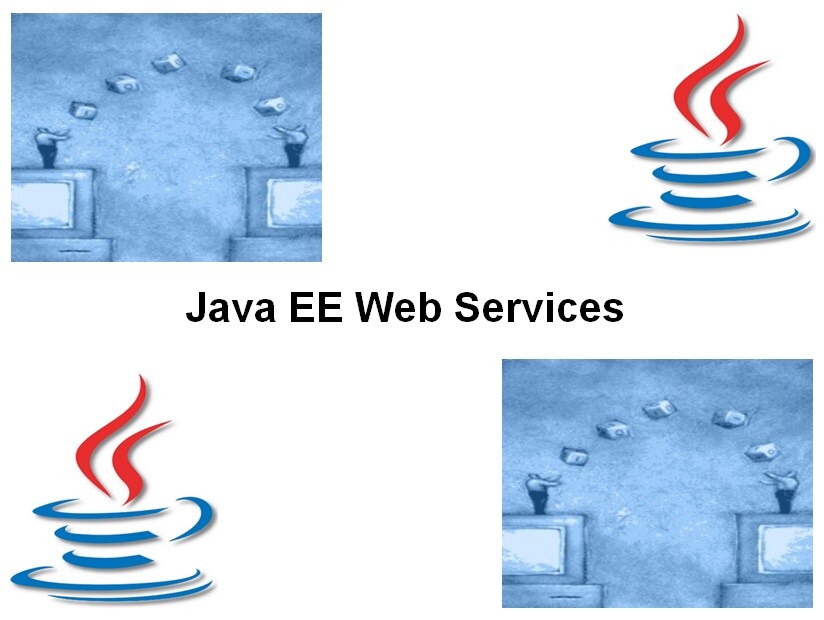- Leren door doen
- Trainers met praktijkervaring
- Klassikale trainingen
- Gedetailleerd cursusmateriaal
- Duidelijke inhoudsbeschrijving
- Maatwerk inhoud mogelijk
- Trainingen die doorgaan
- Kleine groepen
In de cursus Java EE Web Services leert u wat Web Services zijn, hoe u Web Services in Java kunt maken en hoe ze vanuit Java en andere platformen kunnen worden benaderd.
De cursus gaat zowel in op SOAP Web services als op REST Web services.
De verschillende standaarden waar Web Services op gebaseerd zijn worden behandeld, zoals XML Schema, SOAP, WSDL en HTTP voor REST Services.
In het bijzonder is er aandacht voor de verschillende Java API's voor Web Services zoals JAX-WS 2.x, SAAJ (SOAP with Attachment API), JAXB (Java API for XML Binding) en JAX-RS.
Verder wordt aandacht besteed aan waar je op moet letten om ervoor te zorgen dat Web Services interoperabel zijn tussen verschillende platvormen zoals Java en .NET. Eveneens komt de architectuur van moderne Single Page Applications met een REST service backend aan de orde.
En ten slotte komen de verschillende mechanismen en standaarden voor de security van Web Services aan bod. De cursus Java EE Web Services behandelt de onderwerpen die worden gevraagd op het Oracle Java EE Web Services examen.
De cursus Java EE Web Services is bedoeld voor ervaren Java ontwikkelaars die Web Services willen leren ontwikkelen in een Java EE omgeving.
Voor deelname aan deze cursus is kennis van en ervaring met programmeren in Java en met Java EE Web Applicaties vereist.
Deze cursus heeft een hands-on karakter. De theorie wordt behandeld aan de hand van presentatie slides en wordt afgewisseld met praktische oefeningen. Demos worden gebruikt om de theorie te verduidelijken. De cursustijden zijn van 9.30 tot 16.30.
De deelnemers krijgen na het goed doorlopen van de cursus een officieel certificaat Java EE Web Services.

Module 1 : Web Services Intro |
Module 2 : SOAP |
Module 3 : SAAJ |
| What are Web Services? Distributed Applications Evolution Role of interface Interoperability Web Service Types Web Services Stack SOAP Web Services REST Web Services RPC Style Web Services Micro Services Document Style Web Services Service Oriented Architecture |
What is SOAP? SOAP Characteristics SOAP Messages SOAP Body SOAP Headers SOAP Namespaces SOAP Faults SOAP Version differences SOAP Messages as payload Message Exchange Patterns SOAP Intermediaries actor and mustUnderstand attribute |
What is SAAJ? SOAP message structure SOAP Message Parts SOAP Part Attachment Parts SAAJ and DOM SAAJ Class Hierarchy SAAJ Connections Creating a Message Adding Message Elements Sending and Receiving Accessing SOAP Body |
Module 4 : XML-Schema |
Module 5 : JAXB |
Module 6 : WSDL |
| Why XML-Schema? Well formed and valid documents What XML-Schema's? Markup Languages XML Schema Advantages XML Schema design models Classic Use of Schema's XML Namespaces Simple and Complex types XML Schema Data Types User Defined Data Types Derivation by Restriction Derivation by Extension |
XML Processing Options Java API for XML Binding JAXB Architecture JAXB Binding Life Cycle Role of Binding Compiler XML tot Java Mapping Rules Mapping of XML Schema Types JAXB API JAXB Annotations Types Binding Elements and Attributes Named Complex Types Customized Mappings Adapter Classes |
Web Service Description Language WSDL Usage WSDL and Code Generation WSDL in Web Service stack WSDL Namespaces WSDL Structure WSDL Elements Types and Messages PortType and Operations WSDL Bindings Service Element SOAP Messages Modes WSDL 2.0 |
Module 7 : JAX-WS |
Module 8 : Message Handlers |
Module 9 : Asynchronous Calling |
| What is JAX-WS? JAX-WS Design Goals JAX-WS Runtime System JAX-WS Tools Service Endpoint Models JAX-WS Servlet Endpoint Enterprise Java Beans Endpoints JAX-WS Architecture Client Side Programming Models Dynamic Proxy Invocation Model Dispatch Invocation Model |
Message Handlers Characteristics JAX-WS Handler Types SOAP Message Handlers Logical handlers Call Chain Inbound Messages Outbound Messages Processing the Payload Handler Chains Configuring Handler Chains |
Web Service Invocations Supporting Asynchrony Client Side Fire and Forget Client Side Polling Client Side Callbacks Enabling Asynchronous calls Callback Handler Calling Asynchronously Asynchronous Web Services Asynchronous Web Service Model Using WS-Addressing |
Module 10 : REST Services |
Module 11 : Interoperability |
Module 12 : Web Service Security |
| Representational State Transfer REST Web Service Principles ID and Links REST Services in Java JAX-RS and Rest Jersey Content Negotation Embedded Path Parameters @Path and @Param Multiple Representations @Produces and @Consumes Common REST Patterns Resources URI Access XML versus JSON |
WS Interoperability Organization Challenges and Deliverables Profiles Profile Standards Conformance Requirements WS-I Testing Tools Monitor and Analyzer Interoperability Technologies WS-Reliable Messaging WSDL Reliable Messaging Levels of Delivery Assurance Bootstrapping and Configuration Message Transmission Optimization |
Web Service Security Security at Transport level Security at XML Level XML Encryption XML Digital Signature XML Key Management WS-Security Security Enabled SOAP REST Security Access Restriction Restrict HTTP Methods JSON Web Tokens API Keys |
